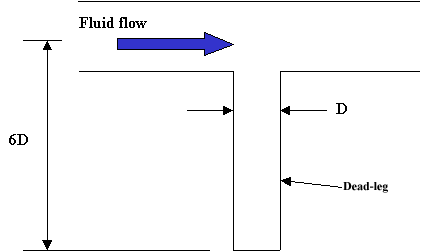| 2003 |

|
YEAR BOOK |
Dublin City University
|
The pharmaceutical industry - dead in the water
|

Research work in the School of Mechanical and Manufacturing Engineering involves a study of the flow and heat mechanisms in the stagnant zone. The use of experimental apparatus and Computational Fluid Dynamics software (CFD) will assist in the study of pipe dead-legs.
The definition of a pipe dead-leg (see figure) as given by the Food and Drug Administration (the FDA) is: 'Pipelines for the transmission of purified water for manufacturing or final rinse should not have an unused portion greater in length than six diameters (the 6D rule) of the unused portion of pipe measured from the axis of the pipe in use'.
The FDA suggests the above 6D rule will help prevent contamination; however industrial experts are designing systems with dead legs limited to 3D or less. Some systems claim to have zero dead legs. The result of this is escalation in design and manufacturing costs within an already highly expensive industry. Considerable basic research is required to address the lack of understanding of this problem and to assist during design, manufacture, installation and operation of these critical systems.
An experimental rig has been designed and constructed to represent a typical pharmaceutical pipe dead leg, allowing an initial study of temperature distribution under turbulent fluid flow conditions. Further studies will involve the use of thermal CFD analysis to map the temperature distribution in the dead leg zone.
Contact: Ben Austen or Brian Corcoran; Tel: (01) 7005770; E-mail: [email protected]